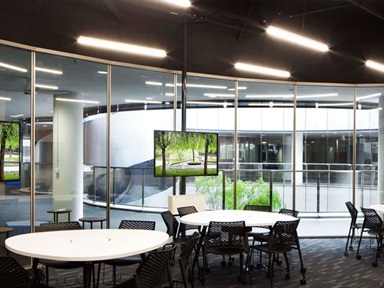Creating a conducive learning environment
Physical Layout & Facilities
The physical layout of the classroom plays an important part in learner engagement. For example, studies suggest that classrooms with round tables, which permit students to face each other, promote interactive learning (Parsons, 2017). The NTU TR+ rooms were specifically designed for this reason.

The 'Climate' (Mood, Focus & Flow) of the Classroom
The learning environment, however, goes beyond the layout and facilities of the classroom. It also includes instructors' relationships with their students (Zpeke & Leach, 2010). The literature suggests that learners become more engaged within a supportive
learning environment when instructors respect them and appreciate their responses (Dallimore, Hertenstein & Platt, 2004; Mottet, Martin, and Myers, 2004). Here are some tips on improving the 'climate' of your class.
10 tips on improving student-teacher relationships
- Get to know the students by name as quickly as possible.
- Get to know some personal things about each student.
- Conduct a values analysis discussion about some current event or topic.
- Provide positive comments when appropriate.
- Be positive and enthusiastic when teaching.
- Show students that you are not only interested in teaching, but that you also care about them.
- Avoid the use of threats and punishment.
- Do not play favourites.
- Create a supportive classroom environment.
- Create an environment where questions and answers - even wrong answers - are encouraged and valued.
Source: Marganett (1995)
10 tips on making lectures more productive
- Begin and end with the learning outcomes.
- If you are using PowerPoint slides, a well-designed slide deck can make a big difference.
- Link lectures to assessment.
- Use a microphone to ensure everyone can hear you.
- Get students to focus on you now and then by not keeping slides up for too long.
- Get students to do things in the lecture (for example, ask them questions, encourage them to ask you questions, solve problems together, hypothesise on possible causes of a certain phenomena, etc.)
- Be mindful of information overload. It is often better for students to think deeply about a few important concepts.
- Break the monotony by adding some humour or some interesting anecdote.
- Keep in mind that the "What's In It For Me?" (WIIFM) question that is on any audience's mind.
- Keep to time. Start on time, end on time.
Source: Race (2009)
For more information on building positive relationships with your students, visit the following pages:
- Developing Positive Teacher-Student Relations in Educator's Guide to Preventing and Solving Discipline Problems. Publisher: ASCD
- First day of class . Eberly Center for Teaching Excellence and Educational Innovation - Carnegie Mellon University.
Boynton, M., & Boynton, C. (2005). The educator's guide to preventing and solving discipline problems. ASCD.
Dallimore, E. J., Hertenstein, J. H., & Platt, M. B. (2004). Classroom participation and discussion effectiveness: Student-generated strategies. Communication Education, 53(1). 103-115. doi: 10.1080/0363452032000135805
Dotterer, A. M., & Lowe, K. (2011). Classroom context, school engagement, and academic achievement in early adolescence. Journal of Youth and Adolescence, 40(12). 1649-1660.
Mottet, T. P., Martin, M. M., & Myers, S. A. (2004). Relationships among perceived instructor verbal approach and avoidance relational strategies and students' motives for communicating with their instructor. Communication Education, 53(1). 116-122. doi: 10.1080/0363452032000135814
Parsons, C. S. (2017). Reforming the Environment: The Influence of the Roundtable Classroom Design on Interactive Learning. Journal of Learning Spaces, 6(3). Available at: http://libjournal.uncg.edu/jls/article/view/1516 Accessed on 28 Feb 2018.
Race, P. (2009) In at the Deep End (2nd revised edition 2009). Leeds Met Press.
Zepke, N., & Leach, L. (2010). Beyond hard outcomes: 'Soft' outcomes and engagement as student success. Teaching in Higher Education, 15(6). 661-673.














/enri-thumbnails/careeropportunities1f0caf1c-a12d-479c-be7c-3c04e085c617.tmb-mega-menu.jpg?Culture=en&sfvrsn=d7261e3b_1)

/cradle-thumbnails/research-capabilities1516d0ba63aa44f0b4ee77a8c05263b2.tmb-mega-menu.jpg?Culture=en&sfvrsn=1bc94f8_1)

7e6fdc03-9018-4d08-9a98-8a21acbc37ba.tmb-mega-menu.jpg?Culture=en&sfvrsn=7deaf618_1)
